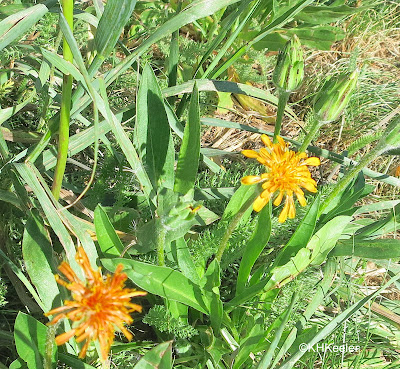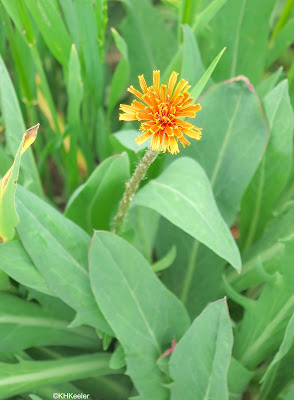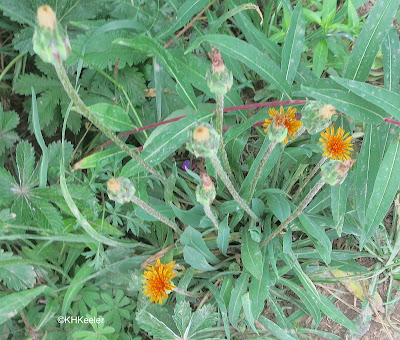Orange mountain dandelion is a an easily-recognized native wildflower of cool areas in western North America.
 |
| orange mountain dandelion Agoseris aurantiaca |
It looks a lot like a dandelion but it is the wrong color. Closer inspection picks up more differences, such as leaves that don't have the characteristic jagged pattern of dandelions, bracts under the flower are upright rather than pointing down the stem as in dandelions, and more. So you can identify it as resembling a dandelion, not a daisy or sunflower, and the flower color is an immediate tip-off it is not the common dandelion (Taraxacum officinale).
What a great color. Unusual and distinctive.
Other common names for this plant are burnt orange false-dandelion and orange agoseris. Like the common dandelion, it is in the sunflower family, Asteraceae, but it is from North America, not Europe.

The scientific name Agoseris is variously interpreted as agos for leader and seris, Greek for chicory. or aix goat and seris, chicory. The species epithet aurantiaca means orange-colored.
 |
| orange agoseris, Agoseris aurantiaca |
This is a plant of the mountains, especially mountain meadows, from New Mexico and Montana west to the Pacific Coast in the United States, north to the Northwest Territories, the Yukon and Alaska, plus South Dakota and Quebec. In Colorado, the habitats it likes are from 5,400' in elevation up to 12,500'.
Despite the name orange mountain dandelion, the flowers are not always orange. Across Colorado they mostly are, but the plant has a continent-wide range and in some places the flowers are pink, yellow, white, red, or purple. Faded flowers are often purplish or reddish. Likewise the leaves vary, some very simple and linear, others with a few lobes (see photo below).
 |
| Leaves with lobes, but not jagged like common dandelions. |
Native Americans sometimes ate the leaves of orange mountain dandelion. The Ramah Navajo used it as a medicine--to cause vomiting, in a lotion on wounds, rubbed on to reduce swelling--as a strengthening tonic and as protection from witches. The Karok used the juice of the root as chewing gum.
Orange mountain dandelion is an uncommon but not especially rare American native wildflower. In Colorado, that orange color is shared mainly by orange hawkweed (Hieracium aurantiacum or Pilosella aurantiaca the authorities don't agree) which is a serious weed from Europe, forms big clones, and despite the efforts of the Department of Agriculture, is probably more common than orange mountain dandelion. Orange mountain dandelion has one flowerhead per flower stalk like a dandelion, orange hawkweed usually has several flowerheads growing off the same flower stalk, among other differences. (See orange hawkweed). You'll probably be in a wild area when you see orange mountain dandelion; orange hawkweed is frequently found near places occupied by people.
Comments and corrections welcome.
References
Ackerfield, J. 2015. Flora of Colorado. BRIT Press, Fort Worth, TX.
Baird, G. I. 2020. Agoseris aurantiaca (Hooker) Greene. Flora of North America. online. (Accessed 7/29/23).
Delmatier, C. and W. Fertig. 2014. Orange mountain dandelion (Agoseris aurantiaca) Plant of the Week. U.S. Forest Service. link (Accessed 7/29/23).
Moerman, D. E. 1998. Native American Ethnobotany. Timber Press, Portland, OR.
Weber, W. A. and R. C. Wittmann. 2012. Colorado Flora. Western Slope. 4th ed. University of Colorado Press, Boulder, CO.
Kathy Keeler, A Wandering Botanist
More at awanderingbotanist.com
Join me on Facebook: https://www.facebook.com/AWanderingBotanist


No comments:
Post a Comment